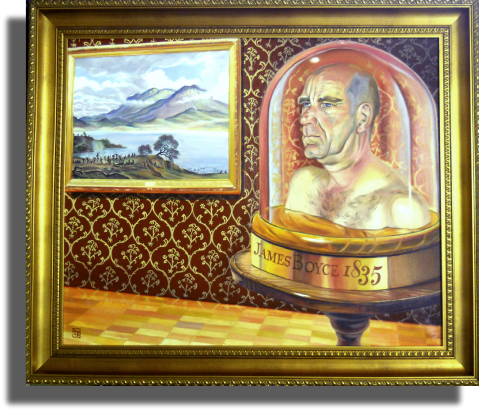©Andrew C Potter 2013

‘James Boyce 1835’, 2011
116cm x 98cm
Oil on Canvas
116cm x 98cm
Oil on Canvas
‘James Boyce 1835’, 2011 by Andrew Potter is a pictorial insight into an Australia that might have been. It evokes the question what if things had been done differently? When the viewer engages with this painting they move into a gallery space from another era. They see a reassuringly traditional painting but the subject matter is perplexing. There is a close-up detailed reproduction of John Glover’s ‘Mount Wellington and Hobart Town from Kangaroo Point’’, 1834, but the white peoples' boats are not in the harbour. The Aborigines appear to be celebrating something. But why is James Boyce in a scientific specimen display just as Truggernana (Truganini) had once been confined in the Tasmanian Museum? James Boyce’s torso stares nonchalantly into space, piercing the paintings' surface to enter the observer's private realm, and blurring the boundary between historian and subject, viewer and victim, and ultimately between past and present.
‘James Boyce 1835’, 2011
116cm x 98cm
Oil on Canvas
116cm x 98cm
Oil on Canvas
‘James Boyce 1835’, 2011, is a pictorial insight into an Australia that might have been. It evokes the question what if things had been done differently? When the viewer engages with this painting they move into a gallery space from another era. They see a reassuringly traditional painting but the subject matter is perplexing. There is a close-up detailed reproduction of John Glover’s ‘Mount Wellington and Hobart Town from Kangaroo Point’’, 1834, but the white peoples' boats are not in the harbour. The Aborigines appear to be celebrating something. But why is James Boyce in a scientific specimen display just as Truggernana (Truganini) had once been confined in the Tasmanian Museum? James Boyce’s torso stares nonchalantly into space, piercing the paintings' surface to enter the observer's private realm, and blurring the boundary between historian and subject, viewer and victim, and ultimately between past and present.